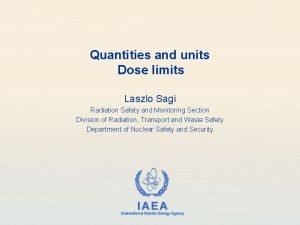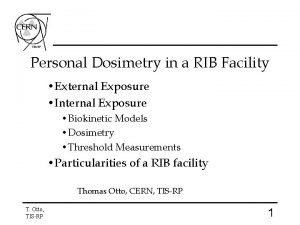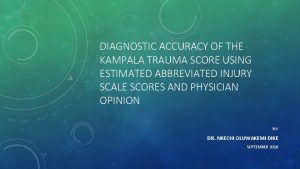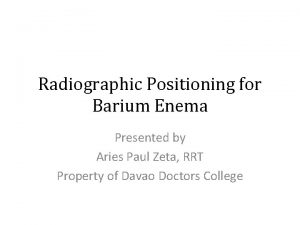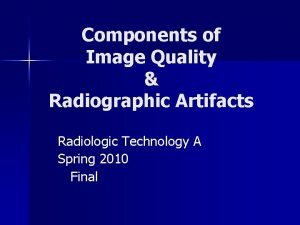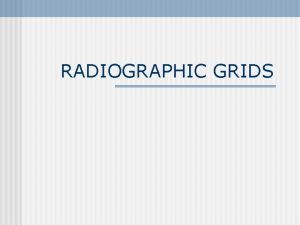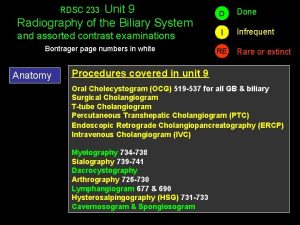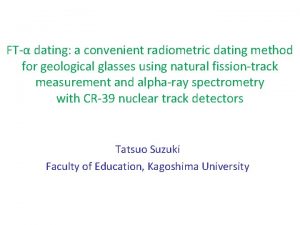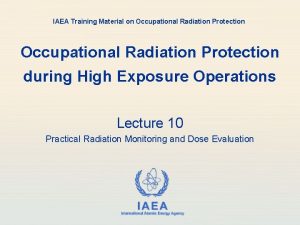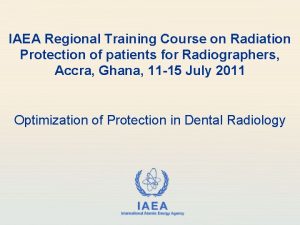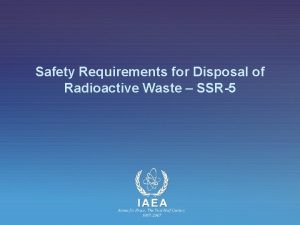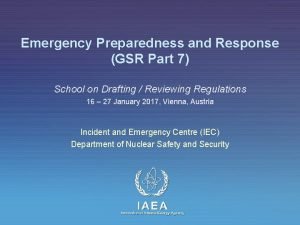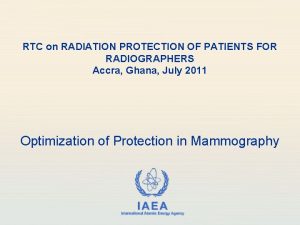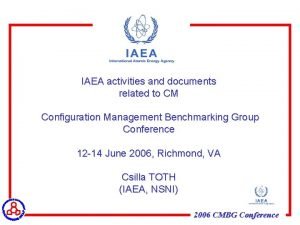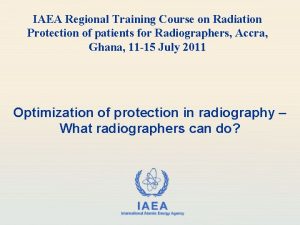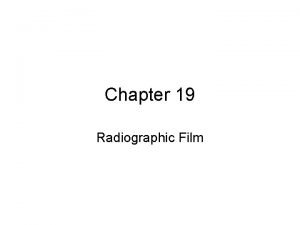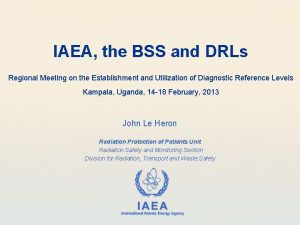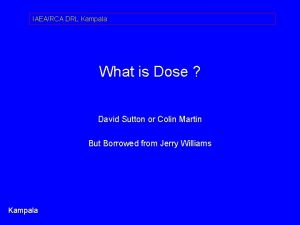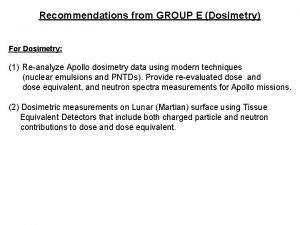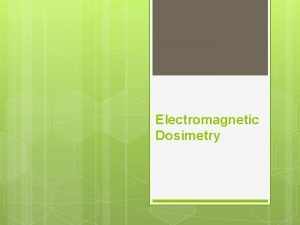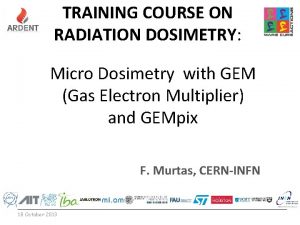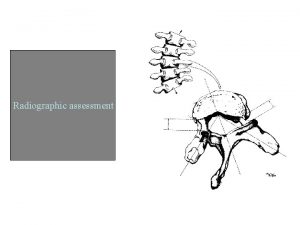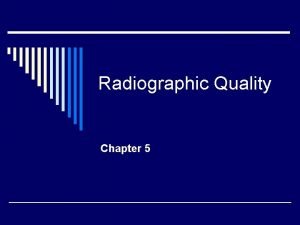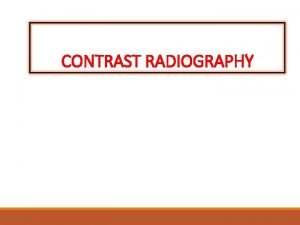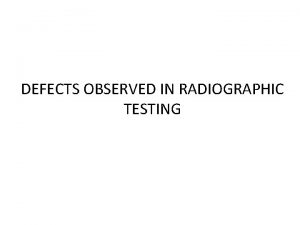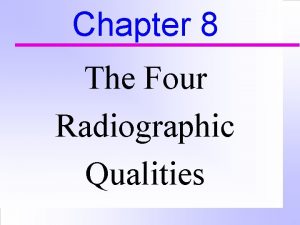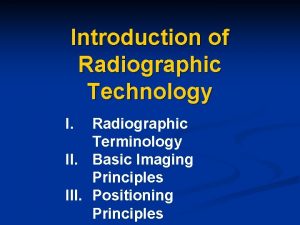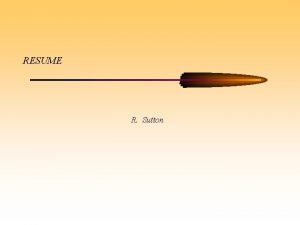IAEA DRLs KAMPALA Radiographic Dosimetry David Sutton Colin





































- Slides: 37

IAEA DRLs KAMPALA Radiographic Dosimetry David Sutton / Colin Martin Dundee Kampala

Reminder…. • Projection radiography (2 D) • Image receptor may be screen-film / CR / DDR • Examinations such as chest, abdomen, limbs, skull …… • Fixed position on body • Relatively low doses Kampala

Dosimetric quantities • Incident air kerma IAK (Ki) – measured for phantoms – calculated for patients • Entrance surface air kerma ESAK (Ke) – measured or calculated for patients • Air kerma-area product KAP (PKA) – measured for patients Kampala

Incident Air Kerma Measured Free in Air on the central beam axis at the focal spot to surface distance. Only primary beam is considered, that is, no scatter contribution. Unit: joule/kg or gray (Gy) Kampala

Entrance Surface Air Kerma (ESAK) • ESAK measured on the surface of the patient or phantom where X-ray beam enters the patient or phantom. • Includes a contribution from photons scattered back from deeper tissues, which is not included in free in air measurements. • Also known as Entrance Surface Dose (ESD) Kampala

Entrance Surface Air Kerma (ESAK) • If measurements are made at other distances than the true focus - to - skin distance, doses must be corrected by the inverse square law and backscatter factor incorporated into the calculation. References: – Dosimetry in Diagnostic Radiology: An International code of practice, TRS 457, IAEA, 2007 – Phys. Med. Biol. 43 (1998) 2237 -2250. Kampala

Air kerma-area product The air kerma-area product, PKA or KAP, is the integral of the air kerma over the area of the X ray beam in a plane perpendicular to the beam axis, thus Unit: Gy m 2 KAP has the useful property that it is approximately invariant with distance from the X ray tube focus (when interactions in air and extra-focal radiation can be neglected), as long as the planes of measurement do not include a significant contribution from backscattered radiation from the patient or phantom. Kampala

Kerma-Area Product: KAP • The kerma - area product (KAP) is defined as the kerma in air in a plane perpendicular to the incident beam axis, integrated over the area of interest. • This is the dose related quantity measured and displayed on all modern X-ray equipment excluding CT (in Europe). KAP meter Kampala

Kerma-Area Product: KAP = K x Area the SI unit of KAP is the Gy·cm 2 Kampala d 1=1 Area = 1 Dose = 1 d 2=2 Area = 4 Dose = 1/4 9

Kerma-Area Product: KAP is independent of distance from the X-ray source, as: n n Air Kerma decreases with the inverse square law. d 1=1 Area = 1 Dose = 1 d 2=2 Area = 4 Dose = 1/4 Area increase with the square distance KAP is usually measured at the level of the tube diaphragms Kampala 10

Dosimetry using Phantoms Kampala

Phantoms • Dosimetry with phantoms only makes sense if AEC is used • With manual setting of m. As phantom is not needed (will only be used as holding device for dosimeter) – Ki measurement can be made free in air without phantom Kampala

Phantoms for general radiography measurements • CDRH Chest & Abdomen/L Spine phantoms • Correspond to average US citizen in PA/AP projection • Incorporate holders for ionization chambers (avoiding back scatter) • Constructed from PMMA & Aluminium (plus air for chest phantom) • Obtainable commercially or can be manufactured Kampala

Kampala

Alternative phantoms • ICRU phantoms – PMMA walls filled with water • ANSI phantoms – PMMA + Al Kampala

Equipment for phantom measurements • Diagnostic dosimeter calibrated for general radiography beam qualities • CDRH chest phantom • CDRH abdomen/lumbar spine phantom • Set of Al attenuators and lead diaphragm for HVL measurements Kampala

Methodology for phantom measurements • Set up equipment for chosen exam of normal adult patient – AEC – tube voltage (k. V) – grid / air gap – focus-skin distance (FSD) – collimation Kampala

Kampala

Calculation of incident air kerma d. FTD : measured tube focus-to-patient support distance in mm dm : distance from the table top (or a wall Bucky) to the reference point of the chamber at the measurement position t. P : thickness of a standard chest (or abdomen/lumbar spine) patient Kampala

Calculation of ESAK Determine appropriate backscatter factor (B) for clinical beam HVL & field-size ESAK =IAK*BSF ~ 1. 35, but there are tables Kampala

Patient dosimetry 1. IAK calculated from measured tube output 2. ESAK calculated from measured tube output 3. ESAK measured using TLD 4. KAP measured using KAP meter on x-ray unit. Kampala

Calculation Kampala

First – know tube output • Equipment for measuring tube output: – Calibrated diagnostic dosimeter – Chamber support stand – Tape measure or ruler Kampala

Calculation of patient incident air kerma • Record technique parameters for examination – tube voltage – tube loading - m. As – focus-skin-distance or focus-film distance (d. FTD) & patient thickness (tp) Where Y(d) is the X-ray tube output (m. Gy/m. As) at distance d from tube Kampala

Calculation of ESAK Determine appropriate backscatter factor (B) for clinical beam HVL & field-size ESAK =IAK*BSF ~ 1. 35, but there are tables Kampala

Alternatively • Measure ESAK to 20 cm perspex at 100 cm FSD • Use inverse square law • But note – IAK is measured as part of QA mesurement Kampala

When can’t you calculate? • When is this approach not possible? – AEC used on a system with no post exposure m. As display – Still possible: TLD or KAP Kampala

Determination of patient doses from measurements on patients (TLDs) Direct determination of patient exposure Kampala

Equipment for direct measurement of ESAK • Thermoluminescence reader (or access to external TLD service) • Well calibrated TLD in sachets • Worksheet for recording data Kampala

Methodology for direct measurement of entrance air kerma • Retain 1 TLD sachet for assessment of background correction • When patient positioned, attach 3 TLD sachets to skin at centre of entrance beam • Record patient & technique data with TLD identification • Remove TLD after exposure & attach to worksheet • Read TLDs to obtain dose readings & background correction Kampala

Entrance air kerma from TLD measurements : mean value of dosimeter readings with background correction kf : correction factor fading of TL signal NK, Qo : dosimeter calibration coefficient k. Q : factor which corrects for differences in the response of the dosimeter at the calibration quality Q 0, and at the quality Q of the clinical X- ray beam Kampala

Sources of uncertainty • Measurement scenario • Precision of reading • Uncertainty in measurement position • Uncertainty in back scatter factors • Uncertainty in TLD correction factors Kampala

Determination of patient doses from KAP measurements Direct determination of patient exposure Kampala

KAP Transmission ionization chamber Kampala

Kerma-Area Product: KAP • It is always necessary to calibrate and to check the transmission chamber for the X-ray installation in use • In some European countries, it is compulsory that new equipment is equipped with an integrated ionization transmission chamber or with automatic calculation methods Radiation Protection in Paediatric Radiology L 02. Understanding radiation units 35

Typical uncertainties • Phantom measurement of IAK: 6 - 12% • Calculation of IAK : 5. 5 - 12. 5% • Calculation of ESAK : 6 - 13% • TLD measurement of ESAK : 12% minimum , but probably a lot more • KAP : up to 25% Kampala

https: //dl. dropbox. com/u/76170928/DRL%20%20 Practical%20 Exercise%20 G 03. xls https: //dl. dropbox. com/u/76170928/DRL%20 Practical%20 Exercise%20 G 02. xls Kampala
 Internal dosimetry
Internal dosimetry Internal dosimetry
Internal dosimetry Kampala trauma score
Kampala trauma score 551555
551555 Kampala trauma score
Kampala trauma score Lamina dura
Lamina dura Mandible x ray positioning towne's
Mandible x ray positioning towne's Reverse towne projection uses
Reverse towne projection uses Labial mounting
Labial mounting Radiographic film
Radiographic film Barium enema positioning
Barium enema positioning Radiographic films
Radiographic films Occipitomental view
Occipitomental view Radiation fog artifact
Radiation fog artifact Off center grid error
Off center grid error Absorption unsharpness
Absorption unsharpness Spectral matching radiography
Spectral matching radiography Radiographic darkroom
Radiographic darkroom Ercp images
Ercp images Iaea
Iaea Iaea
Iaea Pcmf iaea
Pcmf iaea Iaea
Iaea Iaea
Iaea Ssr 5
Ssr 5 Gsr part7
Gsr part7 Part5ds
Part5ds Iaea gsr part 2
Iaea gsr part 2 Stefano monti iaea
Stefano monti iaea Steel scrap
Steel scrap Saris iaea
Saris iaea Pcmf
Pcmf Rtc protection film
Rtc protection film Iaea
Iaea Iaea
Iaea Iaea livechart
Iaea livechart Iaea
Iaea Nuclear wastes
Nuclear wastes
